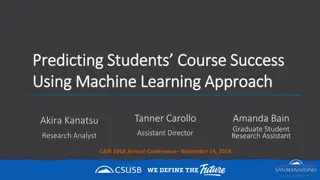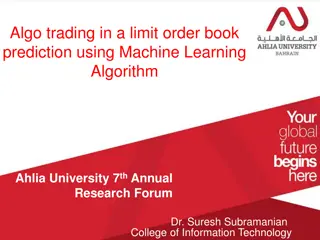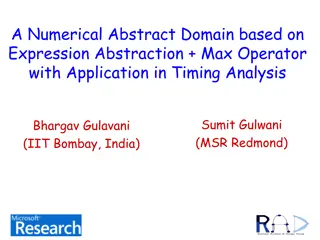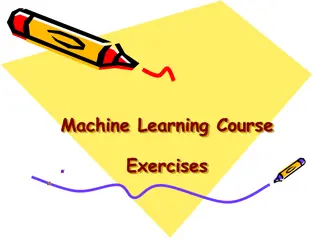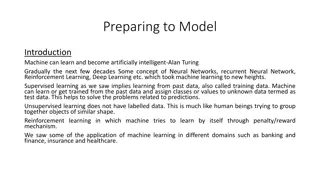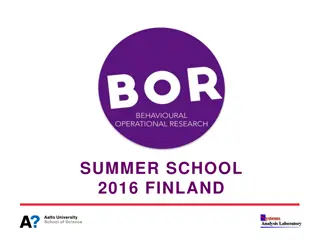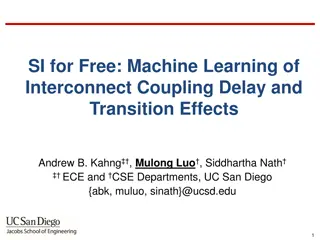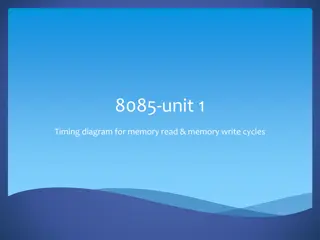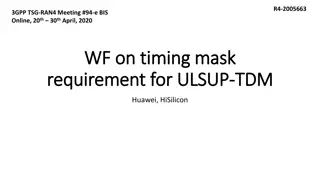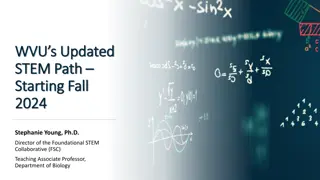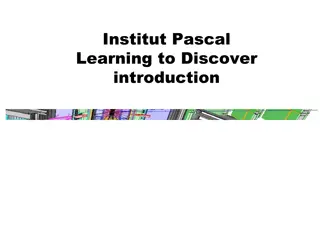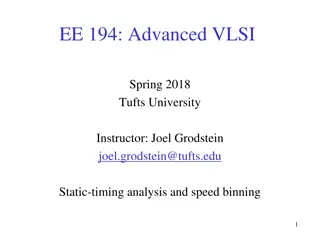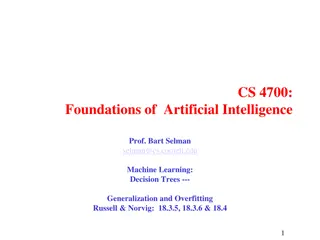Machine Learning for Predicting Path-Based Slack in Timing Analysis
Utilizing machine learning to forecast path-based slack in graph-based timing analysis offers a solution for optimizing power and area efficiency in the design process. The Static Timing Analysis incorporates accurate path-based analysis (PBA) and fast graph-based analysis (GBA) to estimate transition and arrival times, with a focus on accuracy versus runtime tradeoff. Different modes of GBA and PBA are compared for their impact on timing divergence, illustrating the critical balance between accuracy and efficiency.
Download Presentation

Please find below an Image/Link to download the presentation.
The content on the website is provided AS IS for your information and personal use only. It may not be sold, licensed, or shared on other websites without obtaining consent from the author. Download presentation by click this link. If you encounter any issues during the download, it is possible that the publisher has removed the file from their server.
E N D
Presentation Transcript
Using Machine Learning to Predict Path-Based Slack from Graph- Based Timing Analysis Andrew B. Kahng+$, Uday Mallappa$and Lawrence Saul+ UC San Diego $ECE & +CSE Department
Outline Preliminaries Modeling Features Modeling Methodology Experiments Conclusions 2
Static Timing Analysis Graph traversal problem to estimate transition and arrival time at each node Advanced nodes: Multi-corner multi-mode timing scenarios Long runtimes Needed in every iteration of place, route and optimization o Avoid loops in the flow o Avoid overdesign that wastes power and area Accuracy versus Runtime tradeoff o Accurate path-based analysis (PBA) o Fast graph-based analysis (GBA) 3
Timing Analysis in GBA & PBA Modes GBA PBA Path-specific transition propagation and derived arrival time estimation Worst transition propagation and pessimistic arrival time estimation Faster but inaccurate, leading to overdesign Runtime intensive as Launch-Capture logic cone grows in size 4
PBA-GBA (Accuracy vs. Runtime) GBA PBA Arrival Time of 1.803ns Arrival Time of 1.693ns PBA-GBA divergence of 110ps (path-consistent) Accuracy versus Runtime tradeoff Runtime difference as high as 15X for the leon3mp design with 100K flops 5
PBA-GBA divergence (global picture) PBA-GBA divergence values (sorted from high to low) Actual GBA versus Actual PBA path arrival time (megaboom: 350K flops and 990K instances, 1.2ns clock period) 6
Cost of PBA-GBA Slack Divergence GBA SLACK PBA SLACK IMPACT Reduces the ability to exploit available timing slack during power optimization POSITIVE (+) POSITIVE (+) Fixing of false violations schedule, area and power NEGATIVE (-) POSITIVE (+) Over-fixing of timing violations schedule, power and area. NEGATIVE (-) NEGATIVE (-) 7
Previous Work Learning-based methods to predict STA outcomes Han et al. DATE14: miscorrelation between STA tools Kahng SLIP15: prediction of SI from non-SI Onaissi DAC11: determine dominant corner set Bian DAC17: STA in presence of on-chip variations Runtime improvement for timing analysis TAU Workshop: STA accuracy and runtime Huang SLIP15: speedup timing analysis using MapReduce Silva: identify single corner that has worst delay Our work: Predict PBA outcomes from GBA results ! 8
Our Contributions Identify electrical and structural features of the circuit that affect PBA-GBA slack divergence Develop bigram-based predictive model that can capture PBA-GBA slack divergence Generate artificially generated timing paths that can train our predictive model Demonstrate accuracy and robustness of our models on a variety of testcases and use cases 9
Framework: Bigram-Based Modeling Stage-wise or path-wise (lumped) Lumped Model Shield stage-specific details Very large space of features Difficult to debug outlier stages Bigram-based (n = 2) representation In a given path, transition divergence will be translated into arrival time divergence only for the next stage. Bigrams are a Natural Choice ! 10
Outline Preliminaries Modeling Features Modeling Methodology Experiments Conclusions 11
Modeling Features List of Modeling Features for each bigram unit transition time of the first cell transition time of the second cell arrival time of first cell transition time ratio (TR ratio) of first cell arrival time of second cell drive strength of first cell drive strength of second cell functionality of first cell functionality of second cell fanout of first cell load capacitance of first cell accumulated transition time ratio of first cell propagation delay of second cell 12
Feature Importance Dropping TR ratio reduces the model accuracy by 27% Dropping any feature pair that includes TR ratio corresponds to peaks 13
Outline Preliminaries Modeling Features Modeling Methodology Experiments Conclusions 14
Modeling Flow Need Non-linear techniques can capture complex interactions between features Classification and Regression Trees !!! 15
Model Definition Bigram-based Two Stage Model ????= ? ?????,?????,??_??????,??,???_??_??????,?? , ??,??,? Model2 Transition Time Prediction Arrival Time Prediction Model1 ???? = ? ????,?????,?????,??_??????,??,???_??_??????,?? , ??,??,? 16
Reporting Metrics^ Actual GBA Arrival Time (ps) actual_* metric Model PBA model_* metric Actual PBA We use lumped metrics such as 99th percentile value of divergence, mean absolute value of divergence, and worst-case divergence 17
Outline Preliminaries Modeling Features Modeling Methodology Experiments Conclusions 18
Design of Experiments Knobs number of stages in a timing path; standard cell types in the path; launch and capture flop-types; aggressor cell types; load cap range; transition (slew) time values; clock period values. Artificial Circuits Design Name megaboom leon3mp netcard dec_viterbi jpeg_encoder # Instances 990K 450K 303K 61K 40K Real Designs # Flip-flops 350K 100K 66K 26K 4K 19
Model Setup 28nm FDSOI foundry technology libraries Five public benchmark designs along with artificial circuits Three experiments Accuracy versus Robustness Reference Evaluation Actual GBA Model PBA Actual PBA Actual PBA 20
Experiment 1: Accuracy 70% for training and 30% for testing netcard design Predicted PBA Arrival (ps) 19.90ps 39.59ps Actual GBA Arrival (ps) Actual PBA Arrival (ps) Actual PBA Arrival (ps) 21
Experiment 1: Accuracy megaboom leon3mp netcard dec_viterbi jpeg_encoder Actual GBA (ps) Predicted PBA (ps) Actual PBA (ps) 22
Experiment 2: Robustness Timing paths from a post-CTS database for training, and test the model on a post-routed database of the same design. netcard design Predicted PBA Arrival (ps) 33.56 29.63ps Actual GBA Arrival (ps) Actual PBA Arrival (ps) Actual PBA Arrival (ps) 23
Experiment 2: Robustness megaboom leon3mp netcard dec_viterbi jpeg_encoder Actual GBA (ps) Predicted PBA (ps) Actual PBA (ps) 24
Result 3: Robustness Artificial designs and a sample from a real design (30%) for training, and test on (70%) datapoints of the same real design. netcard design Predicted PBA Arrival (ps) Actual GBA Arrival (ps) Actual PBA Arrival (ps) Actual PBA Arrival (ps) 25
Result 3: Robustness megaboom leon3mp netcard dec_viterbi jpeg_encoder Actual GBA (ps) Predicted PBA (ps) Actual PBA (ps) 26
Outline Preliminaries Modeling Features Modeling Methodology Experiments Conclusions 27
Conclusions First to apply machine learning techniques to model PBA-GBA divergence Artificial circuit generation methodology for potential availability during an initial, bootstrap training phase of modeling Model based on decision trees along with electrical and physical features of stage bigrams in timing paths We assess potential benefits of our model using 28nm FDSOI foundry technology Model-predicted PBA arrival times reduce mean, 99th percentile and max divergence metrics by at least 26.6%, 13.4% and 11.7%, respectively as compared to reference PBA-GBA divergence metrics 28
Future Work Integrate our models with an academic sizer and optimizer Obtain practical benefits from improved accuracy-runtime tradeoff Richer artificial testcases that can span the space of timing paths in real designs We see outlier stages (bigrams) that are very different from any artificial training data) Reduction of optimism in PBA slack prediction But: Optimism not viewed as harmful in current use context! Better use of multiple GBA paths to a given endpoint Multiple GBA paths give more information, but our approach does not derive benefit from them! 29
Acknowledgments Dr. Tuck-Boon Chan Dr. Siddhartha Nath Support: NSF, DARPA, Qualcomm, Samsung, NXP, Mentor Graphics, and the C-DEN center. 30
Thank You 31

 undefined
undefined


